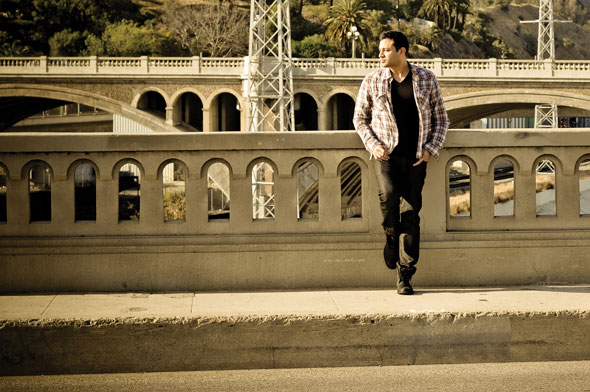Text by Ellen Georgiou
Photography by Farah Sosa

Encouraged by a friend to list all the skills and talents that would help guide him in life, 16-year-old Eddie Cota had only two things on his list, a short list that proved to be more than prophetic:
1. I listen to music
2. I tell people about it.
Today, at 29, Cota is the Artistic Director for Pasadena’s Levitt Pavilion for the Performing Arts and the new Levitt Pavilion at Los Angeles’ MacArthur Park. He not only listens to music and tells people about it, he continues to have an impact on the LA music scene, one artist at a time. Moreover, he assumes the larger tasks of bridging generations (through the Pasadena programs) and encouraging cultural diversity (as seen in the current revitalization of MacArthur Park). This year he includes New York, Texas, Costa Rica, Greece, and Tennessee as destinations for festivals profiling music and to scout new talent. He remains focused, however, on Los Angeles’s unique mix of artists, musical styles and culture and the potential of what it could become.
Since joining Levitt Pavilion in 2008, Cota has transformed what was once a small music organization into a nationally and internationally recognized concert series, producing more than 300 concerts for the nonprofit, which has six sites across the U.S., including Pasadena and MacArthur Park. Last year he booked acts such as the indie-folk duo Belle Brigade, known for their harmonizing vocals; Ana Tijoux from Chile, rumored to be the best Spanish language rapper; Daedelus, who is making his mark in the electronic music world; Ximena Sarinana, a crossover Mexican pop singer-songwriter; and artsy punk rockers No Age.
Cota says he is a professional music fan, and his playlist grows by the minute, whether it’s highbrow jazz, local indie rock, Latino alternative, traditional bluegrass, or surf rock. But ask him what his favorite music is and he cringes and shakes his head. Ask him what he listens to in the car and he can’t do it. Ask him what music he’d take to a desert island and he wears a pained expression. SOMA came up with some easier questions for Eddie Cota.
When did you know music would be such an important part of your life? I realized music “needed” to be part of my life in high school. Before music I was very unmotivated. A transfer student from Yonkers, NY, introduced me to hip hop and artists like Mos Def. I was fascinated by the word play and metaphors. It moved me and I knew it was what I wanted. I decided to study journalism so I could write about music.
Did you do that? No. I realized very quickly that I didn’t want to report on what was happening, I wanted to be part of it.
Did you grow up in the Latin culture? My parents were Mexican immigrants but the culture wasn’t passed down to me. I was an American who was also a Latino and felt quite disconnected. Music was really the first culture I became part of. With music came friends, community. While in college, I worked for Latino 96.3, the first bilingual radio station in LA. There was new music becoming popular: Pitbull, Calle 13, Don Omar. Suddenly Spanglish was acceptable, MTV Tres started and all the Latino magazines – all new media to fit the new demographic and I was at the heart of it. My two worlds collided: Latino culture and urban music. I felt I belonged.
What was your lucky break? In 2007 when I worked independently after leaving radio. My first gig was Pitbull at the Shrine Auditorium. During the show I looked into the crowd from above the stage and saw thousands of people screaming, singing along and having the time of their lives. It gave me chills and I realized bringing concerts to people was not only what I wanted to focus on, but was something I could do well.
Why the move to nonprofit Levitt Pavilion? After hustling to sell tickets for concerts I was promoting, I wanted to do something that was more about the love of music. Levitt was a small concert series, but with free admission it had a built-in audience that filled the venue based on trust. I took advantage of that and started getting creative with programming and made it what it is today—a nationally recognized concert series. In Pasadena the goal is to bring generations together. There’s exciting music happening right now like surf rock, indie folk, retro funk, and experimental jazz that can bring young and old together to
enjoy the same music.
What about LA’s MacArthur Park? MacArthur Park had problems figuring out what music worked there and breaking the stereotype of it being unsafe. Our concerts are now bringing people in from all over LA and the new vibe in the community is amazing. Latin Alternative is one focus, because it brings in young Latinos from other areas, along with traditional Latin music familiar to the local immigrant community. What’s exciting is that MacArthur Park has the potential to be the number one multicultural melting pot in LA, if not the U.S. It’s the most densely populated Latin immigrant community in the United States and is surrounded by artsy, hipster, and young professional neighborhoods. When you put the right artist on stage, they all spill into the park and you have a full representation of what LA is.
What’s playing on your iPod right now? I’m listening to a new group, the Alabama Shakes, who I think will be huge. Gary Clark, Jr., is also exciting. I found this group from Colombia, Monsieur Periné, that I can’t get enough of. Thundercat is one of my current favorites. I like what’s happening in hip hop with new young artists like Kendrick Lamar, and the new electronic styles like moombahton and DJ Munchi coming out of that scene.
It will be a different playlist tomorrow though… for sure.

